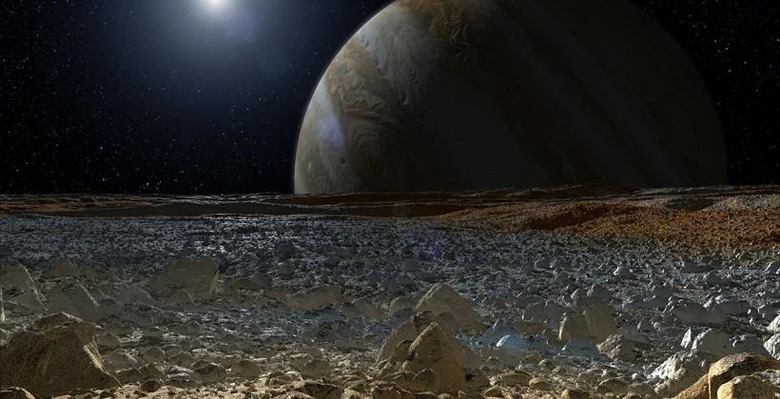This is the tech NASA will take to Jupiter's ice moon
NASA has announced the tech toys its Europa mission will be equipped with, a battery of gadgets to do scientific study with around Jupiter's moon. Nine instruments have been selected after NASA threw open its inbox to suggestions from the research community, in preparation for the $30m study that will hopefully see a solar-powered craft orbit Europa's icy surface for three years. Among the hardware will be instrumentation to figure out if the moon does indeed have huge underground oceans.
NASA's team reviewed thirty-three different instruments suggested after it put out its call last year. "We're confident that this versatile set of science instruments will produce exciting discoveries on a much-anticipated mission," Curt Niebur, Europa program scientist at NASA Headquarters in Washington, said today.
It's certainly shaping up to be an interesting payload. The Plasma Instrument for Magnetic Sounding (PIMS), for instance, will be used to figure out Europa's ice shell thickness, ocean depth, and salinity, working alongside a magnetometer to correct magnetic induction signals for plasma currents around the moon.
More magnetic field measurements will be carried out by the Interior Characterization of Europa using Magnetometry (ICEMAG) tool, which will use multi-frequency electromagnetic sounding to calculate location, thickness, and salinity of the moon's subsurface ocean.
The Radar for Europa Assessment and Sounding: Ocean to Near-surface (REASON) will be used to differentiate between the moon's ice crust from the near-surface to the ocean, while the Mapping Imaging Spectrometer for Europa (MISE) is expected to identify organics, salts, acid hydrates, water ice phases, and other materials in an attempt to figure out just how hospitable to life that ocean might be.
Other tools will investigate Europa's geothermal activity. The Europa Thermal Emission Imaging System (E-THEMIS), for instance, will create heat maps that could flag venting sites, while at the same time the Ultraviolet Spectrograph/Europa (UVS) will do something similar courtesy of technology developed for the Hubble Space Telescope.

The Europa mission will even be equipped to gather samples, though not by landing on the moon. Instead, the SUrface Dust Mass Analyzer (SUDA) will gather up small, solid particles ejected by the moon during low-altitude flybys.
It's a similar approach taken by the MAss SPectrometer for Planetary EXploration/Europa (MASPEX), which will be responsible for atmospheric sampling.
Finally, there'll be more high-resolution photography undertaken by the Europa Imaging System (EIS), as the spacecraft performs a planned 45 flybys at altitudes ranging from 16 miles to 1,700 miles.
NASA expects the camera to map most of the moon at 164 foot resolution, with certain areas captured at up to 100x higher resolution depending on the degree of scientific interest.
If all goes to plan, the mission will take place in the 2020s, though NASA has to convince those in control of the budget to green-light the $30m the trip to Jupiter will require.
SOURCE NASA
